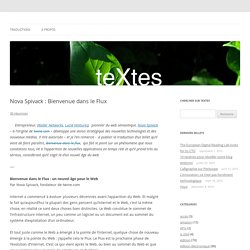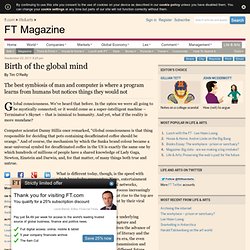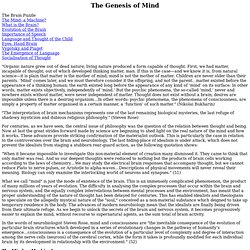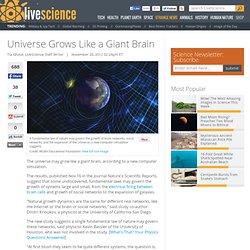

Beverly Macy: The Global Brain, Chaos Theory, and the Power of Real-Time Social Media. In this excerpt from her new book The Power of Real-Time Social Media Marketing (co-authored with Teri Thompson), Beverly Macy offers a view of the global brain, world events, and the immense amount of metadata produced by social media platforms.

Is it really just random, or are we following the laws of nature? As a connected global society, people are sharing opinions, reviews, thoughts, and movements with one another all day, every day. That in itself is remarkable. We call it the real-time global brain. It represents a new form of openness that transcends media, politics, and boundaries and can serve as a powerful search engine, a breaking-news blaster, and an early-warning system. As the body of metadata continues to grow, it becomes even more meaningful and intelligent, giving life to this dynamic global brain. Just as chaos theory states that little changes can have big impacts, the same holds true in real-time marketing. Genetic Atlas Yields a Brainbow of Cognitive Information. Beverly Macy (BeverlyMacy) sur Twitter. Call-Global_Brain_Mind. Nova Spivack : Bienvenue dans le Flux. Entrepreneur, (Radar Networks, Lucid Ventures), pionnier du web sémantique, Nova Spivack – à l’origine de twine.com – développe une vision stratégique des nouvelles technologies et des nouveaux médias.

Il m’a autorisée – et je l’en remercie - à publier la traduction d’un billet qu’il vient de faire paraître, Bienvenue dans le flux, qui fait le point sur un phénomène que nous constatons tous, lié à l’apparition de nouvelles applications en temps réel et qu’il prend très au sérieux, considérant qu’il s’agit là d’un nouvel âge du web. Bienvenue dans le Flux : un nouvel âge pour le Web Par Nova Spivack, fondateur de twine.com Internet a commencé à évoluer plusieurs décennies avant l’apparition du Web. Et malgré le fait qu’aujourd’hui la plupart des gens pensent qu’Internet et le Web, c’est la même chose, en réalité ce sont deux choses bien distinctes. Et tout juste comme le Web a émergé à la pointe de l’internet, quelque chose de nouveau émerge à la pointe du Web : j’appelle cela le Flux. Meta Search Alerts. 001-20 PLATFORM Planetary Nervous System.pdf. The interspecies internet: Peter Gabriel and Vint Cerf at TED2013.
Photos: James Duncan Davidson The internet connects people all over the world.

Twitter and the Global Brain « Thoughtful Cog. The prevailing model for many years of how synapses between neurons in the brain are altered during learning has been Hebbian learning, which can be summarized as “neurons that fire together, wire together”.

In other words, in two neurons fire at the same time, the connection(s) between them will strengthened. But recent evidence in neuroscience shows the truth is actually an interested twist on this idea – a twist that could have important implications as a model of how global consciousness could emerge from real-time social media like Twitter. In reality, synapses are modified according to a rule called Spike Time Dependent Plasticity (STDP). In a nutshell, STDP says that if two neurons fire (= spike) in rapid succession, the connection from the one that fires first to the one that fires second will be strengthened. STDP is a simple idea, but it has been shown to be a surprisingly powerful way that the brain uses for rapid pattern recognition and classification [1][2]
. [2] 1. Global Brain. Matrioshka brain. A matrioshka brain is a hypothetical megastructure proposed by Robert Bradbury, based on the Dyson sphere, of immense computational capacity.

It is an example of a Class B stellar engine, employing the entire energy output of a star to drive computer systems.[1] This concept derives its name from Russian Matrioshka dolls.[2] Concept[edit] ‘Crowdsourcer’ Mark Walsh Picks the Global Brain. “More Parks sausages, Mom!

Please?” Today’s Maryland children don’t remember the series of sausage ads that ran for decades beginning in the 1950s — but their parents do. Little known fact: The familiar plaintive entreaty doesn’t actually come from the little boy featured in the ads. It’s a voiceover performed by none other than Mark Walsh’s mother. Her proud son fills in the details: “You know that ad? During Maryland Gov. Birth of the global mind. The best symbiosis of man and computer is where a program learns from humans but notices things they would not Global consciousness.

We’ve heard that before. In the 1960s we were all going to be mystically connected; or it would come as a super-intelligent machine – Terminator’s Skynet – that is inimical to humanity. And yet, what if the reality is more mundane? Computer scientist Danny Hillis once remarked, “Global consciousness is that thing responsible for deciding that pots containing decaffeinated coffee should be orange.” What is different today, though, is the speed with which knowledge propagates. One might say that this is the same underlying mechanism of human knowledge capture and retransmission that has always driven the advance of civilisation. The web is a perfect example of what engineer and early computer scientist Vannevar Bush called “intelligence augmentation” by computers, in his 1945 article “As We May Think” in The Atlantic.
@T: ALWAYS THE TWAIN »Home. IF Conversations: Howard Bloom on the Global Brain. The Genesis of Mind. The Genesis of Mind.

Tim O'Reilly: Birth of the Global Mind. “The history of civilization is a story of evolution in our ability to build complex ‘multicellular minds,‘" says Tim O’Reilly, founder and CEO of O’Reilly Media (books, conferences, foo camps, Maker Faires, Make magazine.)

Speech allowed us to communicate and coordinate. Writing allowed that coordination to span time and space. Twentieth century mass communications allowed shared information and culture to blanket the world. In the 21st century, memes spread mind to mind in nearly real time. But that's not all. The future belongs not to artificial intelligence, but to collective intelligence. Universe Grows Like A Brain. The universe may grow like a giant brain, according to a new computer simulation.

The results, published Nov.16 in the journal Nature's Scientific Reports, suggest that some undiscovered, fundamental laws may govern the growth of systems large and small, from the electrical firing between brain cells and growth of social networks to the expansion of galaxies. "Natural growth dynamics are the same for different real networks, like the Internet or the brain or social networks," said study co-author Dmitri Krioukov, a physicist at the University of California San Diego. The Strange Neuroscience of Immortality. By Evan R. Goldstein Cambridge, Mass. Illustrations by Harry Campbell for The Chronicle Review In the basement of the Northwest Science Building here at Harvard University, a locked door is marked with a pink and yellow sign: "Caution: Radioactive Material.
" Inside researchers buzz around wearing dour expressions and plastic gloves. Hayworth has spent much of the past few years in a windowless room carving brains into very thin slices. Why? But first he has to die. "If your body stops functioning, it starts to eat itself," he explains to me one drab morning this spring, "so you have to shut down the enzymes that destroy the tissue. " Brain Preservation Foundation. A Computable Universe: Understanding and Exploring Nature as Computation. Author: Hector Zenil Publisher: World Scientific Publishing Company (5/31/2012) "global brain" -inurl:(kelkoo. Towards a Global Brain. Peter Russell More informations about Peter Russel.